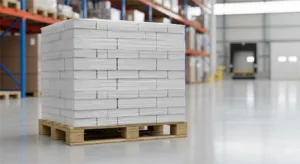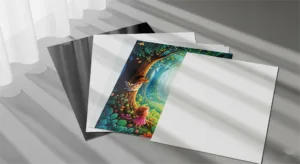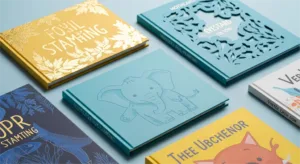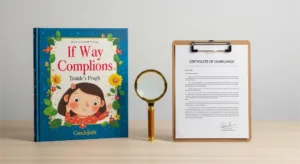Confused by GSM, lbs, and PT when choosing book paper? This guide simplifies paper weight conversions with clear charts and explanations, ensuring you select the perfect paper for your book project.
Book paper weight conversion involves understanding and translating between GSM (grams per square meter), lbs (pounds, varying by paper type), and PT (points, measuring thickness).
- GSM is a consistent international standard, while lbs varies based on paper type (text, cover, bond, etc.), and PT measures thickness in thousandths of an inch.
- To convert GSM to lbs, divide GSM by 1.48 for text paper and 2.71 for cover paper.
- To convert lbs to GSM, multiply lbs by 1.48 for text paper and 2.71 for cover paper.
- PT to mm conversion is achieved by multiplying PT by 0.0254, and mm to PT by dividing mm by 0.0254.
Master paper weight for book printing with our detailed charts and practical tips. Discover how to choose the right paper for your project and avoid common mistakes.
Why Paper Weight Matters for Books

Selecting the right paper impacts:
- Feel & Quality: Heavier paper often feels more premium.
- Opacity: Reduces text/image show-through.
- Durability: Affects longevity and handling.
- Binding: Determines compatibility with binding methods.
- Cost: Influences material and shipping expenses.
Understanding the Units: GSM, lbs, PT, mm
These are the key terms used globally:
| Unit | Full Name | Definition | Primary Use / Region | Key Point |
|---|---|---|---|---|
| GSM | Grams per Square Meter | Weight (g) of 1 sq. meter sheet | International Standard | Consistent & Unambiguous |
| lbs | Pounds (Basis Weight) | Weight (lb) of 500 sheets of a basic size | US / Canada | Varies by Paper Type! |
| PT | Points | Thickness (1 pt = 0.001 inch) | Covers, Cardstock | Measures stiffness/thickness |
| mm | Millimeters | Thickness (1 mm = 0.03937 inch ≈ 39.37 pt) | Metric Thickness / Specs | Direct physical measurement |
The US Basis Weight (lbs) Explained
The confusion with ‘lbs’ comes from its definition varying by paper type:
| Paper Type | Standard Basic Size (for 500 sheets) | Meaning of “80 lb” |
|---|---|---|
| Text Paper | 25″ x 38″ | 500 sheets (25×38″) weigh 80 lbs |
| Cover Paper | 20″ x 26″ | 500 sheets (20×26″) weigh 80 lbs |
| Bond Paper | 17″ x 22″ | 500 sheets (17×22″) weigh 80 lbs |
| Index Bristol | 25.5″ x 30.5″ | 500 sheets (25.5×30.5″) weigh 80 lbs |
| Newsprint | 24″ x 36″ | 500 sheets (24×36″) weigh 80 lbs |
Therefore, 80lb Text is not the same as 80lb Cover. Always specify the type!
Core Conversions: Charts & Formulas
Use these tools for accurate conversions. Remember Text vs. Cover for lbs!
1. GSM ⇄ LBS Conversion
- GSM → lbs (Text): lbs ≈ GSM / 1.48 (or multiply GSM by 0.676)
- GSM → lbs (Cover): lbs ≈ GSM / 2.71 (or multiply GSM by 0.370)
- lbs (Text) → GSM: GSM ≈ lbs * 1.48
- lbs (Cover) → GSM: GSM ≈ lbs * 2.71 (or use 2.708)
Common Conversion Chart: GSM ⇄ LBS (Text & Cover)
| GSM | Approx. Text lbs | Approx. Cover lbs | Notes (Typical Uses) |
|---|---|---|---|
| 80 gsm | 54 lb Text | 30 lb Cover | Novel interior |
| 100 gsm | 68 lb Text | 37 lb Cover | Quality paperback interior, light brochure |
| 120 gsm | 81 lb Text | 44 lb Cover | Trade paperback interior, flyer |
| 150 gsm | 101 lb Text | 55 lb Cover | Art book page, poster, quality brochure |
| 200 gsm | 135 lb Text | 74 lb Cover | Heavy art page, light cover, premium flyer |
| 250 gsm | 169 lb Text | 92 lb Cover | Standard paperback cover, cardstock |
| 300 gsm | 203 lb Text | 111 lb Cover | Premium cover, business card |
| 350 gsm | 236 lb Text | 129 lb Cover | Heavy cardstock, packaging |
(Note: Lbs values are approximate industry equivalents)
2. Thickness ⇄ Weight Conversions (Approximate)
These conversions depend heavily on paper density (bulk). Use as a rough guide only.
PT ⇄ GSM / LBS (Typically for Cover/Cardstock)
| Points (PT) | Approx. GSM | Approx. Cover lbs |
|---|---|---|
| 8 pt | 200-215 gsm | 75-80 lb Cover |
| 10 pt | 230-250 gsm | 85-95 lb Cover |
| 12 pt | 270-300 gsm | 100-110 lb Cover |
| 14 pt | 310-350 gsm | 115-130 lb Cover |
| 16 pt | 350-400 gsm | 130-150 lb Cover |
3. Thickness Conversion: PT ⇄ MM
- PT → MM: mm = PT * 0.0254
- MM → PT: PT = mm / 0.0254 (or mm * 39.37)
Common PT ⇄ MM Chart:
| Points (PT) | Thickness (mm) | Thickness (inches) |
|---|---|---|
| 8 pt | 0.203 mm | 0.008″ |
| 10 pt | 0.254 mm | 0.010″ |
| 12 pt | 0.305 mm | 0.012″ |
| 14 pt | 0.356 mm | 0.014″ |
| 16 pt | 0.406 mm | 0.016″ |
| 18 pt | 0.457 mm | 0.018″ |
To ensure accuracy in your conversions, especially when dealing with different paper types, consider using online paper weight converters which can simplify the process.
Understanding Bulk & Feel

Key Insight: GSM measures weight, not necessarily thickness directly. Bulk describes how thick a paper feels relative to its weight.
- High Bulk: Feels thicker, stiffer, more substantial (e.g., often uncoated paper).
- Low Bulk: Feels thinner, denser, smoother (e.g., often coated paper).
Example: 150gsm Bulk Comparison
| Paper Type | Approx. Thickness | Bulk Level | Impact |
|---|---|---|---|
| 150gsm Uncoated Offset | ~0.18mm / 7pt | Higher | Thicker feel, larger spine |
| 150gsm Coated Gloss/Matte | ~0.14mm / 5.5pt | Lower | Thinner feel, smaller spine |
Conclusion: You must evaluate physical, printed samples to judge the true feel, thickness, and suitability for your project, especially regarding spine width calculations.
The feel and bulk of paper significantly impact the final product. For insights into how paper selection affects the tactile experience, explore this resource on different types of paper for book printing.
Paper Thickness Reference by Type
Thickness varies even within the same GSM based on paper type. (Values approximate, vary by mill).
(Offset Paper – Uncoated)
| GSM | Approx. Thickness (mm) |
|---|---|
| 80gsm | 0.10 mm |
| 100gsm | 0.12 mm |
| 120gsm | 0.14 mm |
| 150gsm | 0.18 mm |
| 200gsm | 0.24 mm |
(Art Paper – Coated Gloss/Matte)
| GSM | Approx. Thickness (mm) |
|---|---|
| 105gsm | 0.09 – 0.10 mm |
| 128gsm | 0.12 – 0.13 mm |
| 157gsm | 0.14 – 0.16 mm |
| 200gsm | 0.18 – 0.20 mm |
| 250gsm | 0.25 – 0.26 mm |
| 300gsm | 0.29 – 0.32 mm |
(Other Common Types – Approx. mm)
| Type / GSM | Thickness (mm) | Type / Thickness | GSM Equiv. |
|---|---|---|---|
| C1S 250gsm | ~0.35 mm | Gray Board 1mm | ~600 gsm |
| C1S 300gsm | ~0.42 mm | Gray Board 2mm | ~1200 gsm |
| Kraft 80gsm | ~0.12 mm | Gray Board 3mm | ~1800 gsm |
| Bible Paper 35gsm | ~0.05 mm | – | – |
Practical Guide: Choosing Paper for Your Book
Use this table as a starting point:
| Book Type | Recommended Interior Paper | Recommended Cover Paper | Key Considerations |
|---|---|---|---|
| Paperback Novel/Text | 70-100 gsm (50-70lb Text) Uncoated (White/Cream) | 250-300 gsm (90-110lb Cover) Coated + Lam. | Readability, Cost |
| Hardcover Text Book | 80-120 gsm (55-80lb Text) Uncoated or Matte Coated | 2-3mm Greyboard + 150gsm Coated Wrap (+Lam) / Cloth | Durability, Quality Feel |
| Coffee Table/Art/Photo Book | 150-200 gsm (100-135lb Text) Coated (Matte or Gloss/Silk) | Usually Hardcover; or Heavy Softcover (300-350gsm / 110-130lb) | Image Quality, Opacity, Premium Feel |
| Children’s Picture Book (Paper) | 120-170 gsm (80-115lb Text) Coated (Matte/Silk often preferred) | Standard Hardcover or Paperback (Laminated) | Durability, Color Vibrancy |
| Children’s Board Book | Thick Paperboard (e.g., 300-400gsm+ layers / ~16pt+) | Integrated Board Cover | Extreme Durability, Safety |
- Finishes: Coated (Gloss/Matte/Silk) = Smoother, better for images. Uncoated = Natural texture, better for text.
- Binding: Check weight limits! Heavy interiors (>200 gsm) challenge perfect binding. Saddle stitch suits lighter weights/fewer pages. Smyth sewing handles more but costs more.
If you’re considering self-publishing, understanding paper types and weights is essential. Learn more here: Self-Publishing: The Complete, No-Nonsense Guide for Authors
Budget Impact: Costs to Consider
- Materials: Heavier & coated papers cost more.
- Shipping: Weight significantly increases freight costs.
- Volatility: Paper prices can change; confirm quote validity.
Tips for Working with Your Printer
- Use GSM: Especially for international communication.
- Get PRINTED Samples: Essential to judge true feel, bulk, and ink interaction.
- Confirm Grain Direction: Ensure it runs parallel to the spine for books.
- Ask for Advice: Leverage your printer’s knowledge of available stocks and options.
Avoiding Common Mistakes
- Don’t confuse lbs Text with lbs Cover.
- Don’t assume GSM = thickness (consider bulk).
- Check binding limits for heavy paper.
- Factor shipping costs for paper weight.
- Use conversion tools correctly (specify paper type).
Conclusion
Mastering book paper weight conversion (using GSM!) and understanding factors like bulk and finish empowers you to make informed choices. Use these charts and tips to select the perfect paper, ensuring quality while managing costs.







